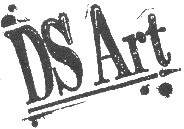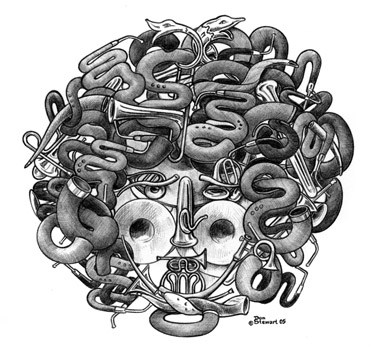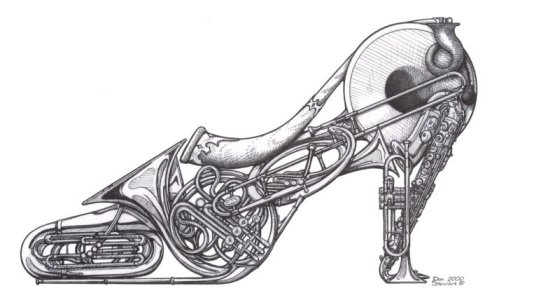"Trombones", "Medusa" and "Shoe Horns"
The Visual Humor of Don Stewart


I was first exposed to Don's composite drawings when a bass trombone student of mine graduated from Boston University. He and his family wanted to thank me for the time I had invested in him and they gave me a beautiful gift - a framed copy of Don Stewart's "Trombones" which they had inscribed with a passage from the Talmud, "Whoever teaches a student teaches that student's students - and so on to the end of man's generations." (Talmud Kedushin, 30a) The inscription was a wonderful gift to me, but that it appeared on Don Stewart's "Trombones" print was almost too much to take! Don has a way of taking ordinary objects and infusing them with new meaning by re-defining them as composite images. Here is Don's "Trombones" drawing:

Of course trombone players make the connection with the word "bone" when we think of our instrument. But it took Don's creative mind to actually DO something with that thought.
I was so taken with Don's "Trombones" drawing that I bought several copies of some of his drawings to give as gifts to family members and friends. Don has also recently come out with an attractive coffee table book that features many of his drawings.
My interest in historical instruments, particularly the serpent, got me thinking about what Don Stewart might do when his mind started to wander over old instruments. I contacted him and asked him if he might someday consider doing a drawing featuring the serpent. After several years (the creative mind sometimes needs time to percolate...) Don told me his newest image had finally come to fruition. When he sent it to me I nearly flipped out of my chair. Here is "Medusa":

Any student who remembers learning about Greek mythology in high school will recall that Medusa was a monster who had snakes for hair and was so horrible that anyone that looked at her would turn to stone. She was finally slain by Perseus who looked at Medusa by her reflection on his shield. Don has taken that image - of Medusa with her hair of snakes - and woven a complex image of historical brass instruments. While dominated by serpents, one can also see English bass horn, buccin (the French form of trombone with zoomorphic bell), cornetto, shofar, cornet, horn, ophicleide and posthorn. The more you look at "Medusa" the more you are transfixed with the complexity of the imagery. Fortunately while doing so you don't turn to stone!
And there is more. . .
One of Don Stewart's most visually arresting images is "Shoe Horns":

Do I need to say anything about THIS image?! The creative melding of so many different kinds of instruments - horns - into this easily recognizable shape is simply masterful. Such is the creative mind of Don Stewart - taking ordinary things and building them into extraordinary images that give us reason to think and smile.
If you find these images to be of interest, you'll be happy to know that Don Stewart has also drawn many other musical instruments which fit into his composite art catalog including trumpet, horn, clarinet, saxophone, tuba and others. His artwork is also quite affordable and would look great in any practice studio or room. "Trombones", for instance, is 15" x 22", a signed limited edition of 500 copies that sells for $50.00. "Shoe Horns," an 11" x 14" limited, signed edition of 500 copies is available for $40.00. "Medusa" is too new to be included yet on Don Stewart's Website but it is available for $30.00, also in a signed, limited edition. I could not be more enthusiastic about Don Stewart's art work and I know many who learn of it will want to have some of his drawings in their home and also share them with friends as gifts. If you visit Don Stewart's Website you can order drawings on line or, in the case of the new "Medusa", call or email him and he'll be happy to fill your order. Thanks, Don, for your part in helping me to enjoy music more every day!
Don Stewart's "Trombones", "Medusa" and "Shoe Horns" drawings and the "DS Art" logo image are © Don Stewart. All rights reserved.
Unauthorised duplication or distribution is prohibited.
Don Stewart's images appear on this page with his kind permission.
©1996-2013 by Douglas Yeo. All rights reserved. |